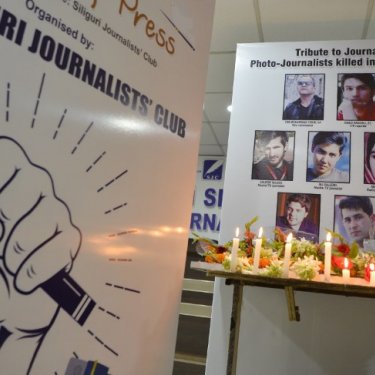More journalists killed in first nine months of 2018 than in all 2017

More professional journalists were killed worldwide in connection with their work in the first nine months of 2018 than in all of 2017, according to the tally kept by Reporters Without Borders (RSF). This year’s total already stood at 56 on 1 October, as against 55 for all of last year. Just over half were killed in war zones.
Worldwide, 2017 was the least deadly year for media personnel in 14 years but this is far from being the case for 2018. In addition to the 56 journalists whose deaths were clearly linked to their work, RSF is in the process of investigating more than 10 other cases.
“As we prepare to unveil the 2018 memorial stone at the memorial park for slain journalists in Bayeux, in northern France, we must pay tribute to all these men and women who have been killed while reporting in war zones” RSF secretary-general Christophe Deloire said. The alarming number of deaths is a reminder of the urgent need to provide journalists with more protection. RSF is calling for the creation of a Special Representative of the United Nations secretary-general. Our initiative is backed by a growing number of governments, and by 130 media outlets, organizations and journalists’ unions around the world.”
Afghanistan is currently the world’s deadliest country for journalists, with 13 killed so far this year, ten of them on a single day, 30 April. Nine, including AFP photographer Sha Marai Fezi, were killed in a double-bombing in Kabul regarded as the deadliest attack on the media since the Taliban government fell in 2001. The tenth victim, BBC reporter Ahmad Shah, was shot dead by unidentified gunmen in eastern Khost province a few hours later.
In all, 29 journalists (52% of the total) have been killed in war zones since the start of the year. After Afghanistan, Yemen has been the deadliest country, with five killed. When not being killed in air strikes, journalists die as a result of mistreatment in prison in this Middle Eastern country, which is ranked 167th out of 180 in the World Press Freedom Index.
This was the case with Anwar al Rakan, a Yemeni journalist who was held by the Houthis for nearly a year. He died on 2 June just days after being released in an already terminal condition. His family said he was ravaged by starvation, torture and disease when released. Photos of his emaciated body circulated on social networks. The Houthis continue to detain at least ten journalists and one citizen-journalist. But they could be holding many more because they provide no information.
In Africa, two journalists have been killed in Somalia. One, Abdirisag Qasim Iman, was fatally shot at a police checkpoint in July. The other, Abdirizak Said Osman, was stabbed to death as he left his radio station in September. In the Central African Republic, a great deal of mystery still surrounds the deaths of three Russian journalists - Orkhan Dzhemal, Kirill Radchenko and Alexander Rastorguyev - who were slain by unidentified gunmen in July while investigating the presence of mercenaries working for Wagner, a Russian private military company that also operates in Syria. Their fixer, known as “Martin,” has yet to be identified and has mysteriously disappeared. The Russian and CAR authorities who are investigating this triple murder have to provide any information that would help to identify those responsible.
A total of six professional journalists have been killed since the start of the year in Pakistan, Palestine and Syria – two in each country. In Syria’s case, this is less than last year, when nine professional journalists were killed in connection with the war. But the dangers continue to grow for Syrian citizen-journalists covering the conflict. Six citizen-journalists and one media worker were killed in Syria during the first nine months of 2018.
